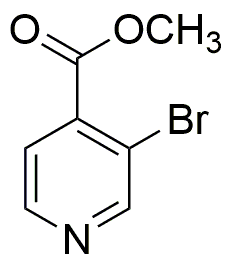Methyl 3-bromoisonicotinate is widely utilized in research focused on:
- Synthesis of Pharmaceuticals: This compound serves as an important intermediate in the synthesis of various pharmaceuticals, particularly in the development of anti-cancer and anti-inflammatory drugs.
- Organic Synthesis: It is commonly used in organic chemistry for creating complex molecules, allowing researchers to explore new compounds with potential therapeutic effects.
- Material Science: The compound finds applications in developing advanced materials, such as polymers and coatings, enhancing their properties for better performance in various industries.
- Agricultural Chemistry: Methyl 3-bromoisonicotinate is utilized in the formulation of agrochemicals, contributing to the development of effective pesticides and herbicides that improve crop yield.
- Biological Research: Researchers use this compound to study biological pathways and mechanisms, aiding in the discovery of new targets for drug development and understanding disease processes.
General Information
Properties
Safety and Regulations
Applications
Methyl 3-bromoisonicotinate is widely utilized in research focused on:
- Synthesis of Pharmaceuticals: This compound serves as an important intermediate in the synthesis of various pharmaceuticals, particularly in the development of anti-cancer and anti-inflammatory drugs.
- Organic Synthesis: It is commonly used in organic chemistry for creating complex molecules, allowing researchers to explore new compounds with potential therapeutic effects.
- Material Science: The compound finds applications in developing advanced materials, such as polymers and coatings, enhancing their properties for better performance in various industries.
- Agricultural Chemistry: Methyl 3-bromoisonicotinate is utilized in the formulation of agrochemicals, contributing to the development of effective pesticides and herbicides that improve crop yield.
- Biological Research: Researchers use this compound to study biological pathways and mechanisms, aiding in the discovery of new targets for drug development and understanding disease processes.
Documents
Safety Data Sheets (SDS)
The SDS provides comprehensive safety information on handling, storage, and disposal of the product.
Product Specification (PS)
The PS provides a comprehensive breakdown of the product’s properties, including chemical composition, physical state, purity, and storage requirements. It also details acceptable quality ranges and the product's intended applications.
Certificates of Analysis (COA)
Search for Certificates of Analysis (COA) by entering the products Lot Number. Lot and Batch Numbers can be found on a product’s label following the words ‘Lot’ or ‘Batch’.
*Catalog Number
*Lot Number
Certificates Of Origin (COO)
This COO confirms the country where the product was manufactured, and also details the materials and components used in it and whether it is derived from natural, synthetic, or other specific sources. This certificate may be required for customs, trade, and regulatory compliance.
*Catalog Number
*Lot Number
Safety Data Sheets (SDS)
The SDS provides comprehensive safety information on handling, storage, and disposal of the product.
DownloadProduct Specification (PS)
The PS provides a comprehensive breakdown of the product’s properties, including chemical composition, physical state, purity, and storage requirements. It also details acceptable quality ranges and the product's intended applications.
DownloadCertificates of Analysis (COA)
Search for Certificates of Analysis (COA) by entering the products Lot Number. Lot and Batch Numbers can be found on a product’s label following the words ‘Lot’ or ‘Batch’.
*Catalog Number
*Lot Number
Certificates Of Origin (COO)
This COO confirms the country where the product was manufactured, and also details the materials and components used in it and whether it is derived from natural, synthetic, or other specific sources. This certificate may be required for customs, trade, and regulatory compliance.


